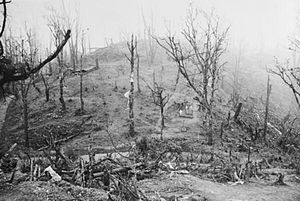Battle of Kohima
| Battle of Kohima | |||||||
|---|---|---|---|---|---|---|---|
| Part of the Burma Campaign of the Second World War | |||||||
 View of the Garrison Hill battlefield, the key to the British defences at Kohima. |
|||||||
|
|||||||
| Belligerents | |||||||
|
|
|||||||
| Commanders and leaders | |||||||
|
|
|
||||||
| Strength | |||||||
|
at start: approx. 1 Infantry Brigade 1500 men fit for duty at end: 2 Infantry Divisions 1 "Chindit" Brigade 1 Motor Brigade |
1 Infantry Division: 12,000–15,000 | ||||||
| Casualties and losses | |||||||
| 4,064 | 5,764–7,000 | ||||||
The Battle of Kohima was the turning point of the Japanese U Go offensive into India in 1944 during the Second World War. The battle was fought in three stages from 4 April to 22 June 1944 around the town of Kohima in Nagaland in northeast India. From 3 to 16 April, the Japanese attempted to capture Kohima ridge, a feature which dominated the road by which the besieged British and Indian troops of IV Corps at Imphal were supplied. By mid-April, the small British and Indian force at Kohima was relieved. From 18 April to 13 May, British and Indian reinforcements counter-attacked to drive the Japanese from the positions they had captured. The Japanese abandoned the ridge at this point but continued to block the Kohima–Imphal road. From 16 May to 22 June, the British and Indian troops pursued the retreating Japanese and reopened the road. The battle ended on 22 June when British and Indian troops from Kohima and Imphal met at Milestone 109, ending the Siege of Imphal.
The battle is often referred to as the "Stalingrad of the East". In 2013, the British National Army Museum voted the Battle of Imphal and Kohima to be "Britain's Greatest Battle".
The Japanese plan to invade India, codenamed U-Go, was originally intended as a spoiling attack against the British IV Corps at Imphal in Manipur, to disrupt the Allied offensive plans for that year. The commander of the Japanese Fifteenth Army, Lieutenant General Renya Mutaguchi, enlarged the plan to invade India itself and perhaps even overthrow the British Raj. If the Japanese were able to gain a strong foothold in India they would demonstrate the weakness of the British Empire and provide encouragement to Indian nationalists in their decolonization efforts. Moreover, occupation of the area around Imphal would severely impact American efforts to supply Chiang Kai Shek's army in China. The objections of the staffs of various headquarters were eventually overcome, and the offensive was approved by Imperial General Headquarters on 7 January 1944.
...
Wikipedia
